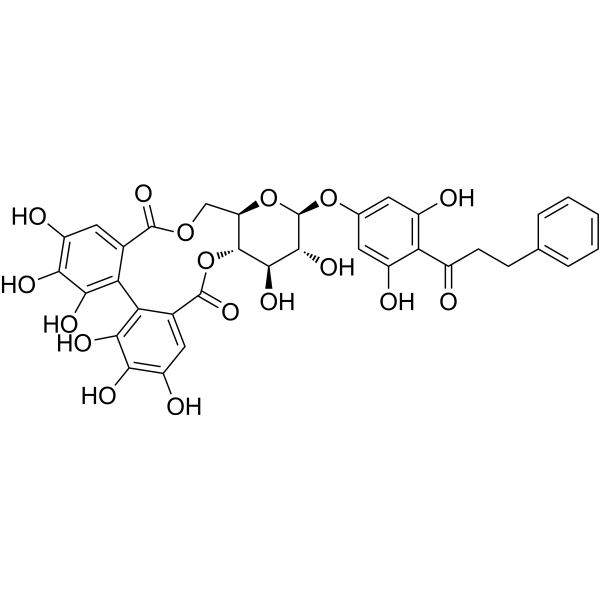
Thonningianin B
CAS No. 271579-12-5
Thonningianin B( —— )
Catalog No. M32670 CAS No. 271579-12-5
Thonningianin B is a natural product from Penthorum chinense Pursh.
Purity : >98% (HPLC)
 COA
COA
 Datasheet
Datasheet
 HNMR
HNMR
 HPLC
HPLC
 MSDS
MSDS
 Handing Instructions
Handing Instructions
| Size | Price / USD | Stock | Quantity |
| 10MG | 461 | In Stock |


|
| 50MG | Get Quote | In Stock |


|
| 100MG | Get Quote | In Stock |


|
Biological Information
-
Product NameThonningianin B
-
NoteResearch use only, not for human use.
-
Brief DescriptionThonningianin B is a natural product from Penthorum chinense Pursh.
-
DescriptionThonningianin B is a natural product from Penthorum chinense Pursh.
-
In VitroCell Viability Assay Cell Line:BV-2 cells Concentration:0-100 μM Incubation Time:24 h Result:Inhibited viability with an IC50 of 46.74 μM.Cell Autophagy Assay Cell Line:BV-2 cells Concentration:10 μM Incubation Time:24 h Result:Significantly improved the ratio of LC3-II/LC3-I and the average number of GFP-LC3 puncta per cell.
-
In Vivo——
-
Synonyms——
-
PathwayOthers
-
TargetOther Targets
-
Recptor——
-
Research Area——
-
Indication——
Chemical Information
-
CAS Number271579-12-5
-
Formula Weight722.6
-
Molecular FormulaC35H30O17
-
Purity>98% (HPLC)
-
SolubilityIn Vitro:?DMSO : 66.67 mg/mL (92.26 mM)
-
SMILES——
-
Chemical Name——
Shipping & Storage Information
-
Storage(-20℃)
-
ShippingWith Ice Pack
-
Stability≥ 2 years
Reference
molnova catalog



related products
-
Amylopectin
Amylopectin is a highly branched polysaccharide based on glucose. It forms starch together with amylose. The glycosidic bond of amylopectin is α- Glucan chain α- 1, 4 and branching points α- 1,6。
-
Thonningianin B
Thonningianin B is a natural product from Penthorum chinense Pursh.
-
IM-156 acetate
IM-156 acetate, an activator of NADH dehydrogenase (IC50=2.2 μM) and AMP-activated protein kinase alpha (AMPKα), is an orally available and bioavailable inhibitor of mitochondrial oxidative phosphorylation (OxPhos).



 Cart
Cart
 sales@molnova.com
sales@molnova.com


